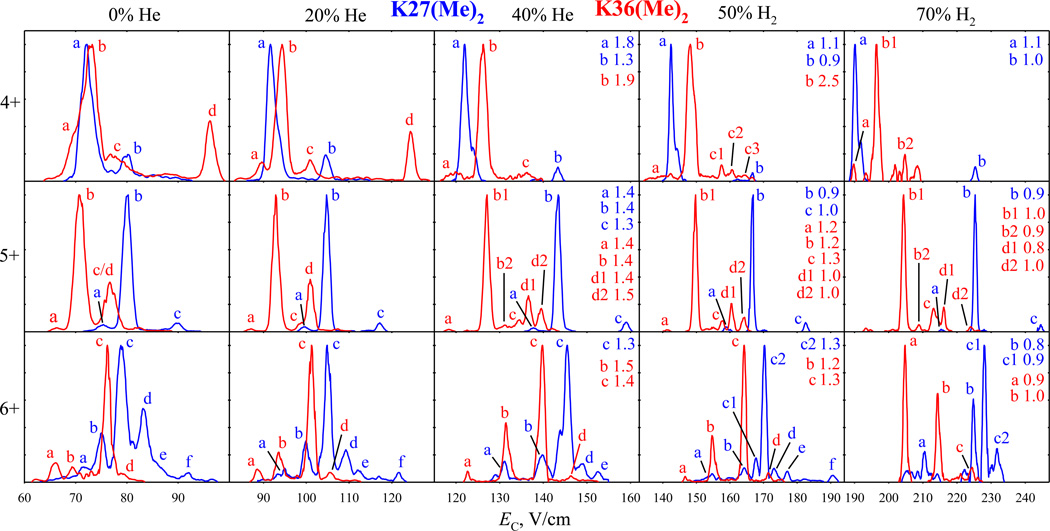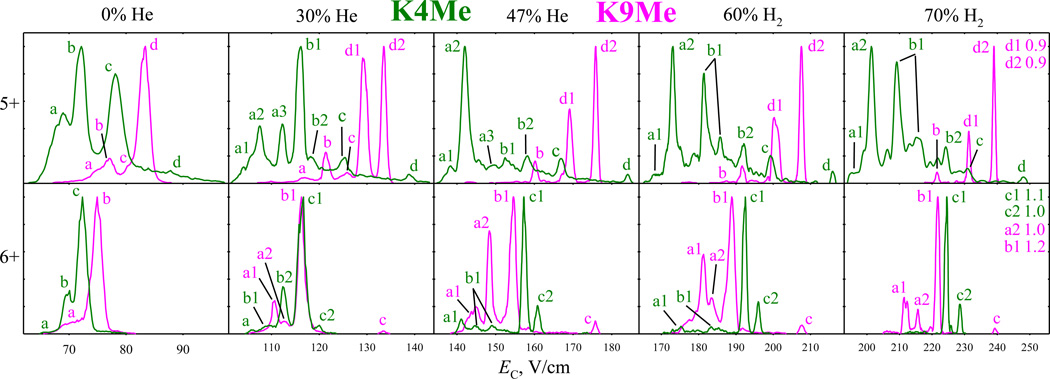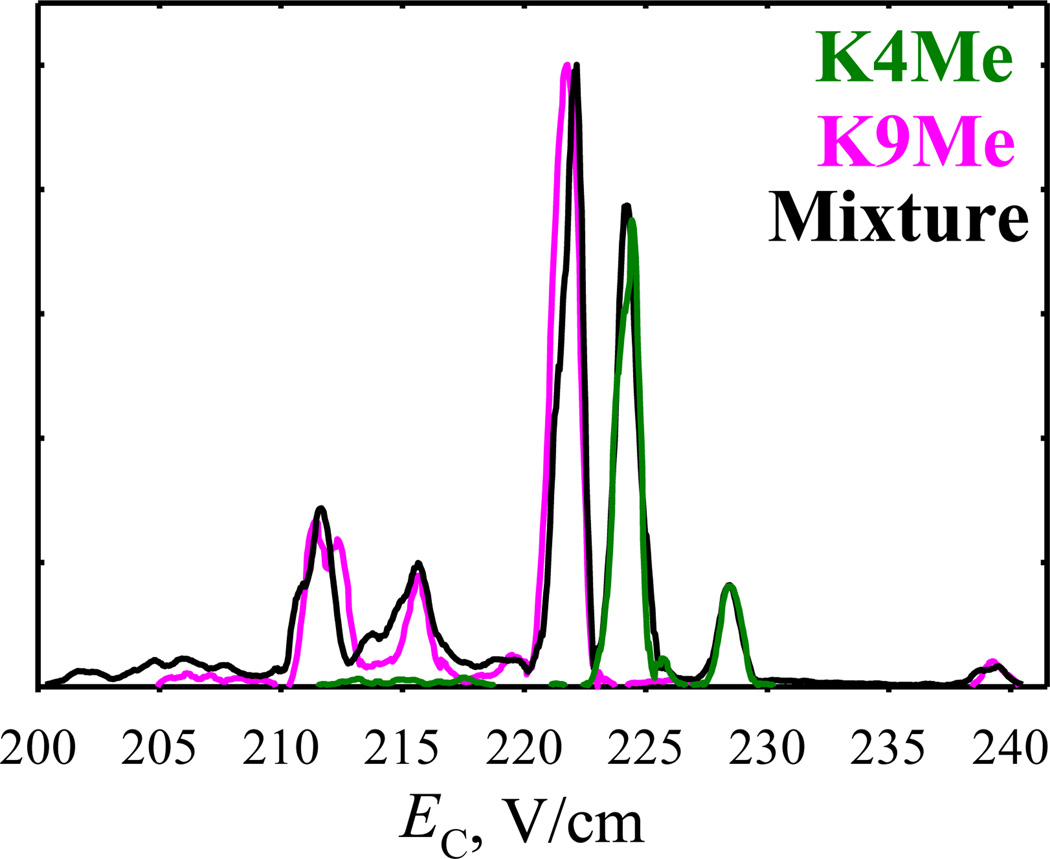Abstract
Differential ion mobility spectrometry (FAIMS) is emerging as a broadly useful tool for separation of isomeric modified peptides with post-translational modifications (PTMs) attached to alternative residues. Such separations were anticipated to become more challenging for smaller PTMs and longer peptides. Here we show that FAIMS can fully resolve localization variants involving a PTM as minuscule as methylation, even for larger peptides in the middle-down range.
Introduction
Biological activity of proteins is largely controlled by post-translational modifications (PTMs). A stellar example is histones and specifically their N-terminal tails, where rich interdependent patterns involving diverse PTMs appear to make up an epigenetic code.1,2 Hence characterization and quantification of PTMs is essential to proteomics.3 Much effort has focused on discovering new PTMs and enriching for and detecting the presence of frequent PTMs such as phosphorylation, glycosylation, nitration, acetylation, and methylation. Pinpointing the position of a PTM on the backbone is also critical, as even minimal shifts can dramatically change the protein function.2,4 For instance, dimethylation of H3 histone is associated2 with transcription activation when on the K4 residue but with heterochromatin and repression when on the neighboring lysine (K9).
Localizing PTMs normally involves tandem mass spectrometry (MS/MS) of either an intact protein or proteolytic peptides via collision-induced dissociation (CID) or electron capture or transfer dissociation (EC/TD).5 Unlike CID, EC/TD mostly avoids cleaving weak bonds to PTMs, moving PTMs between sites, or causing other potentially misleading isomerizations.6 Still, EC/TD has limited sensitivity because of low overall efficiency and distribution of ion signal into many fragment channels,7 and works poorly or not at all for peptides with the charge state (z) of 1 or 2 or “electron predator” PTMs such as nitrate.8 As all MS/MS methods, EC/TD is challenged by sequences where alternative PTM sites are proximal, which yield just one or few distinguishing fragments. A major problem is that multiple PTM localization variants of proteins ubiquitously coexist, commonly with dissimilar populations. Many of these translate into variant peptides upon digestion, especially with non-tryptic proteases that yield longer sequences and therefore higher z preferred for EC/TD. Mixtures of three or more of such species cannot be disentangled by MS/MS in principle, because of non-unique product masses for all parents except two.9 While proteolytic digests are usually fractionated by liquid chromatography (LC) prior to MS/MS, LC often fails to separate localization variants, especially those with nearby alternatively occupied sites.10 In particular, histones with different number of acetylations or methylations are separable by hydrophilic interaction LC (HILIC), but variants for each number generally co-elute.11,12
Localization variants of modified peptides were recently resolved by ion mobility spectrometry (IMS), both conventional IMS13 measuring the absolute mobility (K) at moderate electric field strength (E) and differential or field asymmetric waveform IMS (FAIMS)9,14–16 based on the difference between K values at high and low E. In FAIMS, species with a certain derivative of K(E) over a range of E are selected while traversing a gap between two electrodes carrying the waveform.17,18 A dc “compensation voltage”, also expressed as the compensation field (EC), is superposed on the waveform; scanning EC generates the FAIMS spectrum. The resolving power (R) strongly depends on the gap shape and gas composition; planar-gap geometries (with a homogeneous field) using He/N2 or H2/N2 mixtures allow R up to ~300 for multiply-charged peptides.19,20 This broadly suffices for baseline separation of variant phosphopeptides in the “bottom-up” size range (1.6 – 1.8 kDa),14,15 including those alternatively modified on adjacent residues. Proceeding to smaller PTMs and longer “middle-down” sequences (~3 kDa), we have fully resolved16 all four monoacetylated H4 histone tail variants known in vivo, where the PTM mass relative to the peptide mass (mrel) is only 1.3%. An obvious question is how far this approach extends to yet smaller PTMs and larger peptides.
The smallest additive PTM is the methyl group (14 Da) that can attach to a lysine or arginine once, twice, or thrice. Here we demonstrate that FAIMS can effectively resolve localization variants of singly and doubly methylated histone tails, where the shifting PTM(s) amount(s) to <1% of the peptide mass.
Experimental Methods
The custom FAIMS device coupled to an ion trap mass spectrometer via an electrodynamic funnel interface, and parameters of operation utilizing He/N2 and H2/N2 mixtures have been described.16 The carrier gas inflow was 2 L/min, leading to the filtering time of ~0.2 s. Samples were dissolved to ~2 – 4 uM in 50/49/1 methanol/water/acetic acid and infused to the electrospray source at 0.4 uL/min. We have studied human H3 tails purchased from Anaspec (Fremont, CA): (i) the 1 – 21 segment (ARTK4QTARK9STGGKAPRKQLA) monomethylated on K4 or K9 and (ii) the 21 – 44 segment (ATKAARK27SAPATGGVK36KPHRYRPG) bismethylated on K27 or K36. These feature C-terminal linkers GG (i) or G (ii) followed by a biotinylated lysine, for total masses of 2737 Da (i) and 2945 Da (ii), with mrel of 0.51% (i) and 0.95% (ii). Under present conditions, these species create prominent protonated ions with z = 5 and 6 (i) and 4 – 6 (ii). Again, we have used an internal calibrant (the peptide Syntide 2 that produces abundant 2+, 3+, and 4+ ions) and confirmed separations by analyses of 1:1 isomeric mixtures.14–16
Results
We started from the doubly methylated pair (ii). As usual,14–16 adding He to the gas raises the resolving power as the absolute EC increase while the peaks narrow (Figure 1 and Figure S1 in the Supporting Information). The spectral profiles also evolve. Some changes, such as the peak c/d for K36 5+ splitting into c, d1, and d2, are attributable to improved resolution, whereas progressive disappearance of higher-EC features d for K36 4+ and f for K27 6+ indicates unfolding of more compact conformers induced by field heating in the FAIMS unit.21 The two variants are best separated using z = 5 at 20 – 40% He, with baseline resolution for the major peaks b. Excellent separation of either variant at the dominant peak apexes (a for K27 and b for K36) is also achieved for z = 4 at 30 – 40% He, whereas K36 can be filtered using d at 0 – 20% He. For z = 6, one can resolve K27 from K36 almost completely (using the major feature c at 30 – 40% He), but not vice versa.
Fig. 1.
Normalized FAIMS spectra for two bismethylated localization variants of H3 tail (color-coded on the top) with z = 4 – 6, measured using He/N2 with 0 – 40% He or H2/N2 with 50% or 70% H2 (v/v), as labeled. Peaks for different conformers are marked by letters. The widths (w, V/cm) are shown for the well-shaped peaks at 40% He, 50% H2, and 70% H2. The data for intermediate gas compositions are in Figures S1 and S2.
As for the acetylated tails,16 the spectra at 50% H2 (Figure 1) closely match those at 40% He. Such similarity of conformer distributions using H2/N2 and He/N2 with greater N2 fraction is likely due to weaker field heating in H2/N2 than in He/N2 with equal N2 amount.20 The peaks are narrower at 50% H2 than at 40% He: the mean widths of well-shaped major features are <w> = 1.5 V/cm vs. 1.7 V/cm for z = 4 and 1.1 V/cm vs. 1.4 V/cm for z = 5 – 6. This follows from both lower N2 content in the H2/N2 mixture and slightly narrower peaks in H2/N2 compared to He/N2 with same content.20 With the H2 concentration going to 70%, the EC values increase further while <w> drops to 1.1 V/cm for z = 4 and 0.9 V/cm for z = 5 – 6 (Figure 1 and Figure S2). Higher-EC features continue to vanish, as seen for K36 4+, K27 6+, and K36 6+. The improved resolving power and peak shifts permit full separation of K27 and K36 for z = 6 at 60% H2. However, as the ion signals tend to decrease at higher He or H2 fractions, the lowest fractions providing sufficient resolution are typically optimum.
The case of single methylation (i) was expected to be more difficult in view of the smaller relative PTM mass and size.16 Instead, either variants was easily filtered already in N2: K4 using a major feature a for z = 5 and K9 at the apex of dominant peak b for z = 6 (Figure 2). The trends upon He addition track those for bismethylated variants above: EC values increase while the peaks narrow and split (Figure S3). Again, some higher-EC features progressively decrease and vanish, as seen in the transition from c to b to a for K4 5+. However, others (d2 for K9 5+, c1 for K4 6+, and c for K9 6+) grow at higher He fractions. This perhaps reflects the annealing of metastable unfolded conformers derived from ESI into lower-energy more compact structures.16 The shift of K9 6+ spectrum to lower EC relative to K4 6+ prevents proper filtering of K9 at ~20 – 40% He. The overall resolution still improves at the highest He content, where both variants can be filtered to >96% purity using the major peaks for z = 5 (a2 for K4 and d2 for K9) or z = 6 (c1 for K4 or b1 for K9). The spectra at 50% and 60% H2 (Figure S4) resemble those at 40% and 47% He, respectively, but that at 70% H2 exhibits narrower peaks (<w> = 1.0 V/cm) and cleaner variant separation, with K4 c1 baseline-resolved from K9 b1 for z = 6 (Figure 2).
Fig. 2.
Same as Fig. 1 for two monomethylated variants, measured using He/N2 with 0 – 47% He or H2/N2 with 60% or 70% H2. The data for additional gas compositions are in Figures S3 and S4.
Separations of K4 and K9 in various He/N2 and H2/N2 buffers were verified by analyses of binary mixtures (Figure S5 and Figure 3). A crucial aspect of FAIMS for peptides or other flexible ions is “self-cleaning” – the removal of species that have isomerized and substantially changed EC inside the gap.18,22 This phenomenon, analogous to the elimination of both precursors and products for metastable ions dissociating inside a quadrupole MS filter, may drastically reduce the relative signal for more conformationally flexible peptides. For z = 5, the rapid attenuation of relative signal for K4 upon He addition likely results from that process promoted by augmented field heating, while K9 (with a much more conserved spectral profile) is affected less. The profiles of both variants depend less on the gas composition for z = 6, and their relative intensities remain close to the 1:1 molar ratio in solution. These observations illustrate how the intricate distinctions in thermal stability and unfolding pathways of isomeric peptides can affect and assist FAIMS separations.
Fig. 3.
FAIMS spectrum for the K4Me/K9Me mixture (6+ ions), measured using 7:3 H2/N2. Vertically scaled spectra for the components are overlaid.
As the peak capacity of FAIMS for peptides is determined mainly by the relative separation width wrel (the ratio of highest to lowest EC for different species in a spectrum), the relationship between wrel and mrel is key to the utility of approach for larger polypeptides. For the previously investigated four-variant sets, wrel at the highest He content (in the charge state with maximum wrel) were ~9mrel, namely ~0.4 for phosphopeptides (mrel = 5.0%) and ~0.13 for acetylated peptides (mrel = 1.3%).16 Thus, wrel would have been ~0.09 for present bismethylated and ~0.05 for monomethylated peptides. The actual values (~0.25 and ~0.27, respectively) are ~3 – 5 times higher already with two species, showing that the variant separation can much exceed the projections from the data for larger PTMs, assuming proportionality to mrel. This brightens the prospects for separation of localization variants for yet larger peptides and intact proteins.16
Conclusions
Regioisomers of peptides differing in the site of single or double methylation are readily resolved by FAIMS, even for larger (~3 kDa) peptides where the methyl makes a mere 0.5% of the mass. Along with broad separation of acetylated variants,16 this enables a new approach to characterization of histones that exhibit extremely complex complements of biologically consequential PTM localizations. Why has FAIMS been immediately able to separate localization variants with all PTMs tried so far, even those minute relative to the whole peptide? An intriguing supposition is that IMS methods exploit the crucial life function of PTMs - adjusting the protein conformations and evolution thereof under external stimuli.
Supplementary Material
Acknowledgments
We thank Ron Moore for experimental help. Parts of this research were supported by NIGMS (GM 067193-09 and GM 103493-10), NCI (CA 155252), Northwestern University Physical Sciences Oncology Center (CA 143869), and the Chicago Biomedical Consortium. Work was performed in the Environmental Molecular Sciences Laboratory, a US DoE national scientific user facility at PNNL.
References
- 1.Carey N. The Epigenetics Revolution. Columbia University Press; 2012. [Google Scholar]
- 2.Mosammaparast N, Shi Y. Annu. Rev. Biochem. 2010;79:155–179. doi: 10.1146/annurev.biochem.78.070907.103946. [DOI] [PubMed] [Google Scholar]
- 3.Mann M, Jensen ON. Nature Biotechnol. 2003;21:255–261. doi: 10.1038/nbt0303-255. [DOI] [PubMed] [Google Scholar]
- 4.Sweet SMM, Mardakheh FK, Ryan KJP, Langton AJ, Heath JK, Cooper HJ. Anal. Chem. 2008;80:6650–6657. doi: 10.1021/ac800963a. [DOI] [PubMed] [Google Scholar]
- 5.Bailey DJ, Rose CM, McAlister GC, Brumbaugh J, Yu P, Wenger CD, Westphall MS, Thomson JA, Coon JJ. Proc. Nat’l Acad. Sci. 2012 doi: 10.1073/pnas.1205292109. [DOI] [PMC free article] [PubMed] [Google Scholar]
- 6.Kim MS, Pandey A. Proteomics. 2012;12:530–542. doi: 10.1002/pmic.201100517. [DOI] [PMC free article] [PubMed] [Google Scholar]
- 7.Molina H, Horn DM, Tang N, Mathivanan S, Pandey A. Proc. Natl. Acad. Sci. U.S.A. 2007;104:2199–2204. doi: 10.1073/pnas.0611217104. [DOI] [PMC free article] [PubMed] [Google Scholar]
- 8.Sohn CH, Chung CK, Yin S, Ramachandran P, Loo JA, Beauchamp JL. J. Am. Chem. Soc. 2009;131:5444–5459. doi: 10.1021/ja806534r. [DOI] [PMC free article] [PubMed] [Google Scholar]
- 9.Xuan Y, Creese AJ, Horner JA, Cooper HJ. Rapid Commun. Mass Spectrom. 2009;23:1963–1969. doi: 10.1002/rcm.4101. [DOI] [PubMed] [Google Scholar]
- 10.Singer D, Kuhlmann J, Muschket M, Hoffman R. Anal. Chem. 2010;82:6409–6414. doi: 10.1021/ac100473k. [DOI] [PubMed] [Google Scholar]
- 11.Lindner H, Sarg B, Meraner C, Helliger W. J. Chromatogr. A. 1996;743:137–144. doi: 10.1016/0021-9673(96)00131-8. [DOI] [PubMed] [Google Scholar]
- 12.Garcia BA, Pesavento JJ, Mizzen CA, Kelleher NL. Nat. Methods. 2007;4:487–489. doi: 10.1038/nmeth1052. [DOI] [PubMed] [Google Scholar]
- 13.Ibrahim Y, Shvartsburg AA, Smith RD, Belov ME. Anal. Chem. 2011;83:5617–5623. doi: 10.1021/ac200719n. [DOI] [PMC free article] [PubMed] [Google Scholar]
- 14.Shvartsburg AA, Creese AJ, Smith RD, Cooper HJ. Anal. Chem. 2010;82:8327–8334. doi: 10.1021/ac101878a. [DOI] [PMC free article] [PubMed] [Google Scholar]
- 15.Shvartsburg AA, Singer D, Smith RD, Hoffmann R. Anal. Chem. 2011;83:5078–5085. doi: 10.1021/ac200985s. [DOI] [PMC free article] [PubMed] [Google Scholar]
- 16.Shvartsburg AA, Zheng Y, Smith RD, Kelleher NL. Anal. Chem. 2012;84:4271–4276. doi: 10.1021/ac300612y. [DOI] [PMC free article] [PubMed] [Google Scholar]
- 17.Guevremont R. J. Chromatogr. A. 2004;1058:3–19. [PubMed] [Google Scholar]
- 18.Shvartsburg AA. Differential Ion Mobility Spectrometry: Nonlinear Ion Transport and Fundamentals of FAIMS. Boca Raton: CRC Press; 2008. [Google Scholar]
- 19.Shvartsburg AA, Smith RD. Anal. Chem. 2011;83:23–29. doi: 10.1021/ac202386w. [DOI] [PMC free article] [PubMed] [Google Scholar]
- 20.Shvartsburg AA, Smith RD. Anal. Chem. 2011;83:9159–9166. doi: 10.1021/ac202386w. [DOI] [PMC free article] [PubMed] [Google Scholar]
- 21.Shvartsburg AA, Prior DC, Tang K, Smith RD. Anal. Chem. 2010;82:7649–7655. doi: 10.1021/ac101413k. [DOI] [PMC free article] [PubMed] [Google Scholar]
- 22.Shvartsburg AA, Li F, Tang K, Smith RD. Anal. Chem. 2007;79:1523–1528. doi: 10.1021/ac061306c. [DOI] [PubMed] [Google Scholar]
Associated Data
This section collects any data citations, data availability statements, or supplementary materials included in this article.





